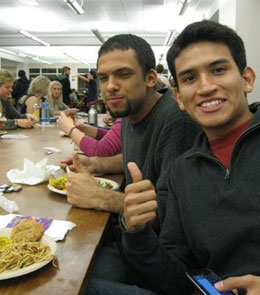As Michelle Obama struggles with pushback from Congress on bringing healthy food to US schools, universities are charging ahead toward sustainable food.
In May, California approved a sustainable food policy that requires the entire 23-campus system to source at least 20% of food from local farms and businesses that meet the Real Food Challenge, impacting $100 million spent on food.
Across the country,
140 universities, such as Johns Hopkins, Brown, UC Berkeley, Indiana University, and UNC Chapel Hill, have signed onto the Real Food Challenge, measuring and reporting on the amount of sustainably-produced food served on campus.
And 22 universities pledge to raise the proportion of "real food" served to 20%, 30% or 40% by 2020.

A majority of students say they consider an institution’s level of sustainability in their decision on where to attend college, says Real Food Challenge, a student organization that spans 300+ campuses.
The group has developed an online calculator where schools aggregate thousands of food purchasing records and assess their ‘real food’ score. Student researchers then grade products against a comprehensive set of 3rd party-verified standards for local, fair, ecologically sound and humane food. When completed, The Real Food Calculator shows how a school is doing and how they can improve.
Over 600 student researchers have reviewed 84,297 products and $71 million worth of campus food purchases.
"Using the Calculator, I can now tell you that 81% of my school’s seafood comes from sustainable fisheries . And we now know that, compared to other universities, we could source more fair trade items, such as rice – the item we buy the most of," says Anna Hankins, a freshman at University of Massachusetts/ Amherst.
Founded in 2008, the goal of Real Food Challenge is to shift $1 billion in university food spending away from industrial agriculture and junk food and towards local, fair, ecologically sound, and humanely produced food – ‘real food.’
Massachusetts’ Hampshire College, long known for progressive leadership, has decided to see if it can source 100% of the food served on campus locally.
According to the 2014 Locavore Index, Vermont leads the country on local food for the third consecutive year.
"This ranking reflects the commitment Vermonters make to community based agriculture," says Chuck Ross, Vermont’s Secretary of Agriculture, Food and Markets. "From the farm and food system entrepreneurs who are providing local foods, to the schools and institutions that are stepping up to integrate local foods, to the individual Vermonters who are making healthy, local choices, our state has embraced a systems approach to agriculture."
Building a Regional Food System
And that needs to extend to all of New England, says a report by American Farmland Trust, Conservation Law Foundation and Northeast Sustainable Agriculture Working Group.
Although Maine ranks #2 and New Hampshire #3 on the Locavore index, the region has lost 300,000 acres of farmland in the last 30 years. About half of the dairy consumed is produced locally, less than 40% of vegetables, 10% of fruit, and 1% of meat, according to New England Food Policy: Building A Sustainable Food System.
Learn more about Real Food Challenge:
